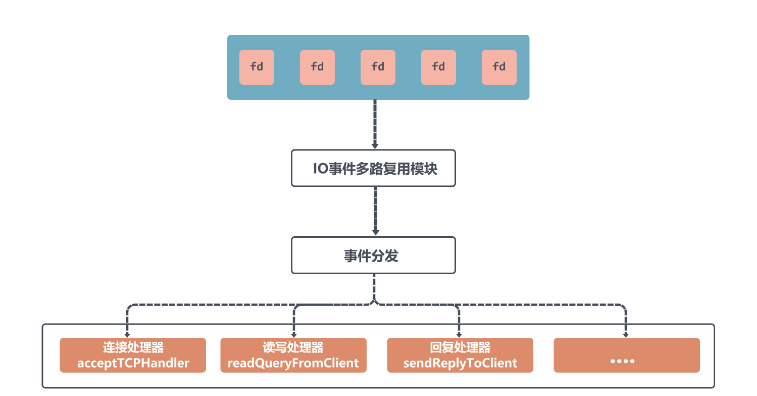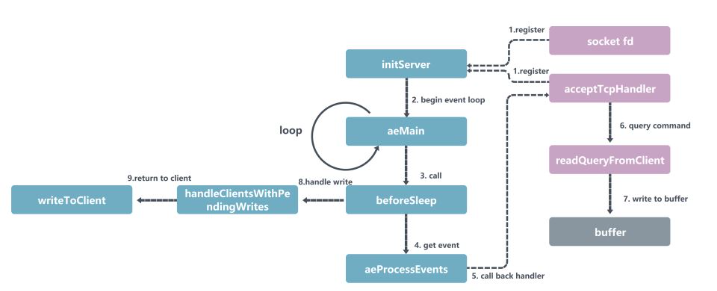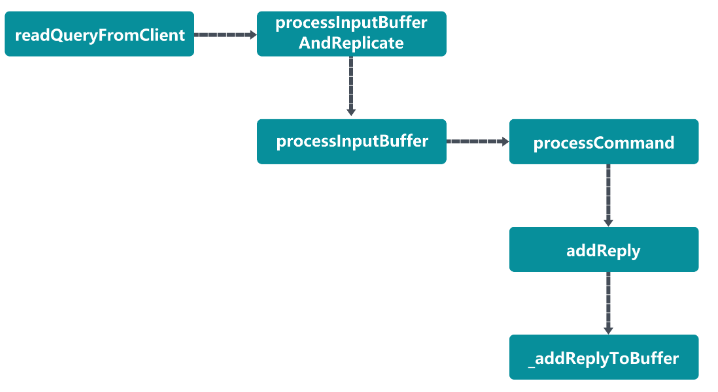What is the process of Redis request processing?
Overview
#The first is to register the processor;
Open the loop listening port, and create a Goroutine every time a connection is monitored ;
Then the Goroutine will wait in a loop to receive the request data, and then match the corresponding processor in the processor routing table according to the requested address, and then hand the request to the processor for processing ;
It’s expressed in code like this:
func (srv *Server) Serve(l net.Listener) error {
...
baseCtx := context.Background()
ctx := context.WithValue(baseCtx, ServerContextKey, srv)
for {
// 接收 listener 过来的网络连接
rw, err := l.Accept()
...
tempDelay = 0
c := srv.newConn(rw)
c.setState(c.rwc, StateNew)
// 创建协程处理连接
go c.serve(connCtx)
}
}It’s a little different for Redis, because it is single-threaded and cannot use multi-threading to handle connections. Therefore, Redis chooses to use an event driver based on the Reactor pattern to implement concurrent processing of events.

The so-called Reactor mode in Redis is to monitor multiple fds through epoll. Whenever these fds respond, epoll will be notified in the form of events for callbacks. Each Each event has a corresponding event handler.
For example: accept corresponds to the acceptTCPHandler event handler, read & write corresponds to the readQueryFromClient event handler, etc., and then the event is assigned to the event processor for processing through the event loop dispatch.
So the above Reactor mode is implemented through epoll. For epoll, there are mainly three methods:
//创建一个epoll的句柄,size用来告诉内核这个监听的数目一共有多大 int epoll_create(int size); /* * 可以理解为,增删改 fd 需要监听的事件 * epfd 是 epoll_create() 创建的句柄。 * op 表示 增删改 * epoll_event 表示需要监听的事件,Redis 只用到了可读,可写,错误,挂断 四个状态 */ int epoll_ctl(int epfd, int op, int fd, struct epoll_event *event); /* * 可以理解为查询符合条件的事件 * epfd 是 epoll_create() 创建的句柄。 * epoll_event 用来存放从内核得到事件的集合 * maxevents 获取的最大事件数 * timeout 等待超时时间 */ int epoll_wait(int epfd, struct epoll_event * events, int maxevents, int timeout);
So we can implement a simple method based on these three methods Server:
// 创建监听
int listenfd = ::socket();
// 绑定ip和端口
int r = ::bind();
// 创建 epoll 实例
int epollfd = epoll_create(xxx);
// 添加epoll要监听的事件类型
int r = epoll_ctl(..., listenfd, ...);
struct epoll_event* alive_events = static_cast<epoll_event*>(calloc(kMaxEvents, sizeof(epoll_event)));
while (true) {
// 等待事件
int num = epoll_wait(epollfd, alive_events, kMaxEvents, kEpollWaitTime);
// 遍历事件,并进行事件处理
for (int i = 0; i < num; ++i) {
int fd = alive_events[i].data.fd;
// 获取事件
int events = alive_events[i].events;
// 进行事件的分发
if ( (events & EPOLLERR) || (events & EPOLLHUP) ) {
...
} else if (events & EPOLLRDHUP) {
...
}
...
}
}Calling process
#So according to the above introduction, you can know that for Redis, an event loop is nothing more than a few steps:
-
Register event listening and callback functions;
Loop to wait for events to be acquired and processed;
Call the callback function to process data logic;
Write data back to Client;

Register fd to epoll, And set the callback function acceptTcpHandler. If there is a new connection, the callback function will be called;
Start an infinite loop to call epoll_wait to wait and continue to process the event. Later we will return to the aeMain function to loop the call aeProcessEvents function;
When a network event comes, the callback function acceptTcpHandler will be called all the way to readQueryFromClient for data processing. readQueryFromClient will parse the client's data and find the corresponding cmd function. Execution;
After receiving the client request, the Redis instance will process the client command and write the returned data into the client output buffer instead of returning immediately;
Then the beforeSleep function will be called every time the aeMain function loops to write the data in the buffer back to the client;
The entire event above In fact, the code steps of the loop process have been written very clearly, and there are many articles on the Internet about it, so I won’t go into details.
Command Execution Process & Writeback Client
#Command Execution
# Let’s talk about something that is not mentioned in many articles on the Internet and see how Redis executes commands. , then store it in the cache, and write the data back to the client from the cache.

We also mentioned in the previous section that if a network event comes, the readQueryFromClient function will be called, which is where the command is actually executed. We will just follow this method and look down:
readQueryFromClient will call the processInputBufferAndReplicate function to process the requested command;
In the processInputBufferAndReplicate function It will call processInputBuffer and determine whether the command needs to be copied to other nodes if it is cluster mode;
processInputBuffer function will loop through the requested command and call it according to the requested protocol processInlineBuffer function, after calling the redisObject object, processCommand is called to execute the command;
processCommand will use lookupCommand to find the corresponding command according to the command in the
server.commandstable when executing the command. Execute the function, and then after a series of verifications, call the corresponding function to execute the command, and call addReply to write the returned data into the client output buffer;
server. commands will register all Redis commands in the populateCommandTable function as a table that obtains command functions based on the command name.
For example, to execute the get command, the getCommand function will be called:
void getCommand(client *c) {
getGenericCommand(c);
}
int getGenericCommand(client *c) {
robj *o;
// 查找数据
if ((o = lookupKeyReadOrReply(c,c->argv[1],shared.nullbulk)) == NULL)
return C_OK;
...
}
robj *lookupKeyReadOrReply(client *c, robj *key, robj *reply) {
//到db中查找数据
robj *o = lookupKeyRead(c->db, key);
// 写入到缓存中
if (!o) addReply(c,reply);
return o;
}Find the data in the getCommand function, and then call addReply to write the returned data into the client output buffer .
Data write-back client
#After writing the command into the buffer, the data needs to be taken out from the buffer and returned to the client. For the process of writing data back to the client, it is actually completed in the event loop of the server.

First of all, Redis will call the aeSetBeforeSleepProc function in the main function to register the function beforeSleep of the writeback package into the eventLoop;
-
Then when Redis calls the aeMain function for the event loop, it will determine whether beforesleep has been set. If so, it will call it;
beforesleep function will call Go to the handleClientsWithPendingWrites function, which calls writeToClient to write data back to the client from the buffer.
The above is the detailed content of What is the process of Redis request processing?. For more information, please follow other related articles on the PHP Chinese website!

Hot AI Tools

Undresser.AI Undress
AI-powered app for creating realistic nude photos

AI Clothes Remover
Online AI tool for removing clothes from photos.

Undress AI Tool
Undress images for free

Clothoff.io
AI clothes remover

Video Face Swap
Swap faces in any video effortlessly with our completely free AI face swap tool!

Hot Article

Hot Tools

Notepad++7.3.1
Easy-to-use and free code editor

SublimeText3 Chinese version
Chinese version, very easy to use

Zend Studio 13.0.1
Powerful PHP integrated development environment

Dreamweaver CS6
Visual web development tools

SublimeText3 Mac version
God-level code editing software (SublimeText3)

Hot Topics
 1389
1389
 52
52
 How to build the redis cluster mode
Apr 10, 2025 pm 10:15 PM
How to build the redis cluster mode
Apr 10, 2025 pm 10:15 PM
Redis cluster mode deploys Redis instances to multiple servers through sharding, improving scalability and availability. The construction steps are as follows: Create odd Redis instances with different ports; Create 3 sentinel instances, monitor Redis instances and failover; configure sentinel configuration files, add monitoring Redis instance information and failover settings; configure Redis instance configuration files, enable cluster mode and specify the cluster information file path; create nodes.conf file, containing information of each Redis instance; start the cluster, execute the create command to create a cluster and specify the number of replicas; log in to the cluster to execute the CLUSTER INFO command to verify the cluster status; make
 How to clear redis data
Apr 10, 2025 pm 10:06 PM
How to clear redis data
Apr 10, 2025 pm 10:06 PM
How to clear Redis data: Use the FLUSHALL command to clear all key values. Use the FLUSHDB command to clear the key value of the currently selected database. Use SELECT to switch databases, and then use FLUSHDB to clear multiple databases. Use the DEL command to delete a specific key. Use the redis-cli tool to clear the data.
 How to read redis queue
Apr 10, 2025 pm 10:12 PM
How to read redis queue
Apr 10, 2025 pm 10:12 PM
To read a queue from Redis, you need to get the queue name, read the elements using the LPOP command, and process the empty queue. The specific steps are as follows: Get the queue name: name it with the prefix of "queue:" such as "queue:my-queue". Use the LPOP command: Eject the element from the head of the queue and return its value, such as LPOP queue:my-queue. Processing empty queues: If the queue is empty, LPOP returns nil, and you can check whether the queue exists before reading the element.
 How to use the redis command
Apr 10, 2025 pm 08:45 PM
How to use the redis command
Apr 10, 2025 pm 08:45 PM
Using the Redis directive requires the following steps: Open the Redis client. Enter the command (verb key value). Provides the required parameters (varies from instruction to instruction). Press Enter to execute the command. Redis returns a response indicating the result of the operation (usually OK or -ERR).
 How to use redis lock
Apr 10, 2025 pm 08:39 PM
How to use redis lock
Apr 10, 2025 pm 08:39 PM
Using Redis to lock operations requires obtaining the lock through the SETNX command, and then using the EXPIRE command to set the expiration time. The specific steps are: (1) Use the SETNX command to try to set a key-value pair; (2) Use the EXPIRE command to set the expiration time for the lock; (3) Use the DEL command to delete the lock when the lock is no longer needed.
 How to read the source code of redis
Apr 10, 2025 pm 08:27 PM
How to read the source code of redis
Apr 10, 2025 pm 08:27 PM
The best way to understand Redis source code is to go step by step: get familiar with the basics of Redis. Select a specific module or function as the starting point. Start with the entry point of the module or function and view the code line by line. View the code through the function call chain. Be familiar with the underlying data structures used by Redis. Identify the algorithm used by Redis.
 How to solve data loss with redis
Apr 10, 2025 pm 08:24 PM
How to solve data loss with redis
Apr 10, 2025 pm 08:24 PM
Redis data loss causes include memory failures, power outages, human errors, and hardware failures. The solutions are: 1. Store data to disk with RDB or AOF persistence; 2. Copy to multiple servers for high availability; 3. HA with Redis Sentinel or Redis Cluster; 4. Create snapshots to back up data; 5. Implement best practices such as persistence, replication, snapshots, monitoring, and security measures.
 How to use the redis command line
Apr 10, 2025 pm 10:18 PM
How to use the redis command line
Apr 10, 2025 pm 10:18 PM
Use the Redis command line tool (redis-cli) to manage and operate Redis through the following steps: Connect to the server, specify the address and port. Send commands to the server using the command name and parameters. Use the HELP command to view help information for a specific command. Use the QUIT command to exit the command line tool.




